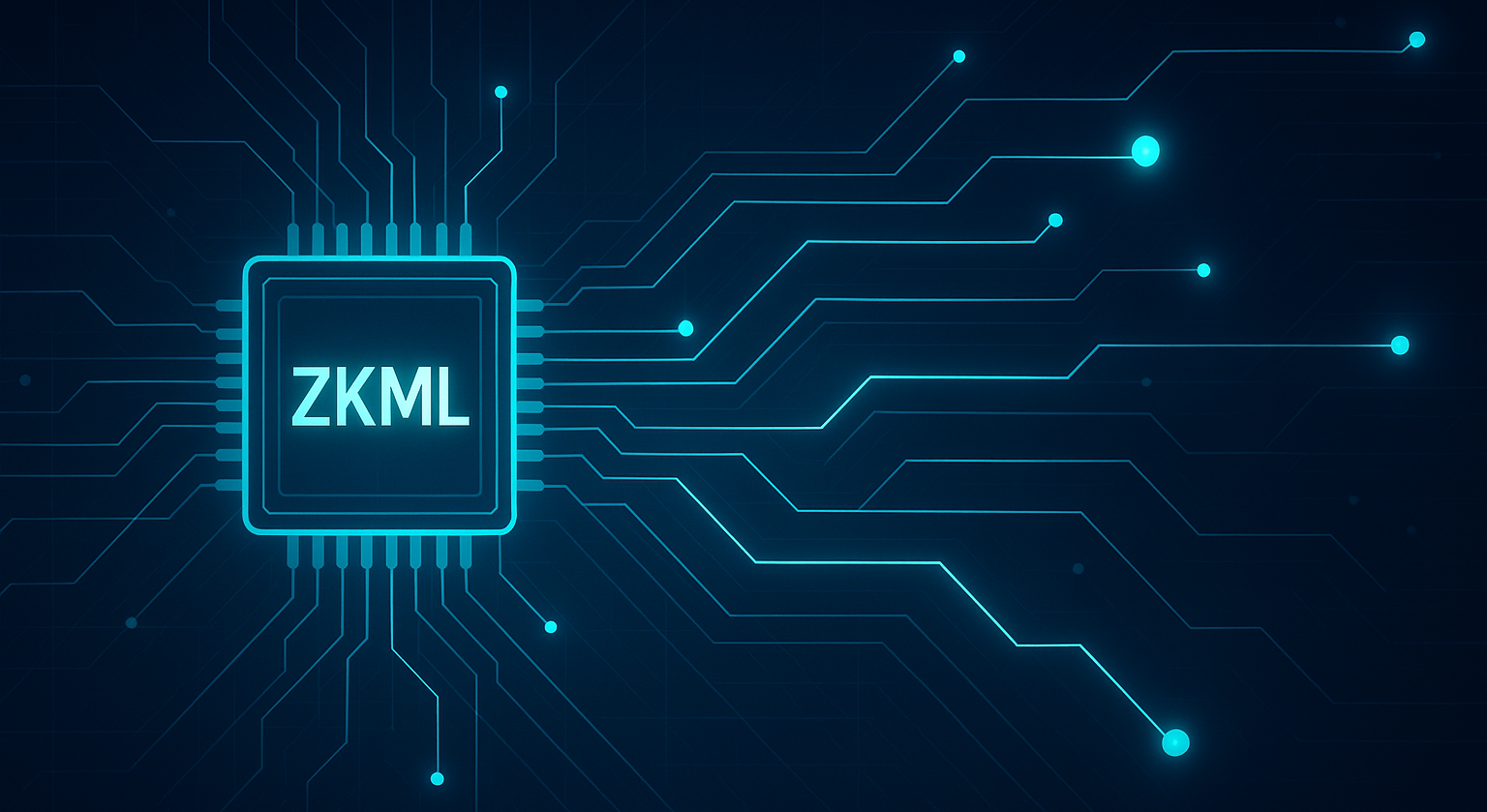Zero‑knowledge machine learning (zkML) lets you prove an AI model ran as specified—on specific inputs, with specific weights—without revealing any sensitive data. That single capability turns AI from a “black box” to a verifiable service you can meter, audit, and sell across trust boundaries.
Why now?
- It’s become economically relevant. AI spend is exploding—analysts report ~$1.5T in 2025, on track for $2T+ by 2026—with a big chunk flowing into inference and services. Even small efficiency or assurance gains are now material. (Network World)
- Regulation is here. The EU AI Act entered into force on Aug 1, 2024, with obligations phasing in through 2025–2026—putting a price on auditability, traceability, and risk controls. (European Commission)
- Proof systems just got faster. The ICME stack (Sumcheck + Lookups) reports 3–7× zkML speedups versus prior art, moving proofs from “R&D” to “pilotable.” For how/why, read the technical post: ICME.
What zkML is
- You keep data and model private. Yet you prove to a partner, regulator, or customer that the model output was produced honestly and policy‑compliantly.
- The proof is small and fast to check. You can verify it in a database, a regulator portal, or even on‑chain to power pay‑per‑inference markets.
- Result: lower compliance and integration risk, new revenue channels (verifiable APIs), and fewer partner NDAs/data copies.
For engineers: Sumcheck enforces the algebra, lookups simplify range/lookup checks, and Jolt emulates CPU‑style execution—all optimized for ML circuits. Start there for details and benchmarks. (ICME)
High‑ROI use cases
1. Regulated finance: “Proof‑of‑compliance” for AI decisions
Problem: Financial institutions spend staggering sums to comply with AML/KYC, sanctions, model risk, and audit controls.
Global financial‑crime compliance costs were $206B in 2023; regional 2024 updates show $61B (US/CA), $85B (EMEA), $45B (APAC)—and rising. Even a 1% efficiency gain is material. (LexisNexis Risk Solutions)
What zkML delivers
- A cryptographic receipt that a sanctioned‑party screen or credit model ran with the approved weights/policies on the declared inputs—no PII exposure to vendors.
- Selective disclosure for regulators: prove the decision met thresholds (e.g., PD < X) without revealing the model itself.
- Cross‑border compliance with less data movement.
2. Advertising & attribution: Private, verifiable measurement
Measurement is fragile under privacy change; fraud siphons budgets.
Opportunity size: Digital ad spend tops $1T in 2025 (≈75% of all media), while $84B was lost to ad fraud in 2023 and could approach $170B by 2028. Cutting even 1% waste on digital would save ≈$7.5B/year. (EMARKETER)
What zkML delivers
- Attribution proofs: “This conversion matched campaign logic across parties” without exposing user‑level data.
- Bid integrity: prove the bidder’s model followed declared fairness/brand‑safety filters.
- Fraud throttling: require proofs with each impression/click to make large‑scale botting uneconomic.
3. Pay‑per‑inference markets (on‑chain or cross‑org): Meter AI like a utility
Selling model access across firms or marketplaces means trust, metering, and chargeback headaches.
AI’s macro value pool is enormous—$2.6–$4.4T in annual impact across industries (McKinsey). With AI infrastructure spend surging toward $1.5T in 2025 and $2T+ by 2026, marketplaces for verifiable inference become economically attractive. On‑chain settlement is more feasible post‑EIP‑4844’s fee drop. (McKinsey & Company)
What zkML delivers
- Usage‑based billing with proofs: each inference comes with a receipt proving model/version/input constraints.
- Dispute‑resistant SLAs: settle payments or refunds automatically when proofs fail.
- Composability: proofs can be verified by customers, auditors, or smart contracts.
Specific zkML Benefits
- Prover performance & TCO: Benchmarks for your exact model class (CNNs, transformers, tree ensembles). Ask for end‑to‑end latency at target batch sizes and the verifier cost (including any on‑chain fees). ICME’s recent results claim 3–7× speedups for zkML; validate on your workloads. (ICME)
- Policy expressiveness: Can you prove business rules (thresholds, monotonicity, fairness checks) alongside the model step—without exploding proof size? (This is where Good Lookups/+Good≠ matter.) (ICME)
- Deployment surface: Support for regulator portals, partner APIs, or L2 verification if you need automated settlement. Post‑EIP‑4844 costs should be clear in any on‑chain option. (Investopedia)
- Governance & audit: Evidence that model artifacts/keys are versioned and that proofs bind to those exact versions; compatibility with EU AI Act documentation. (European Commission)
- Roadmap: GPU‑accelerated proving and support for your hardware; ask for a line of sight to <200ms proof latency for your hot paths.
Why this is a board‑level opportunity
- Scale of spend: AI investments are reaching macroeconomic scale (trillions), so verifiability is a lever with enterprise‑level impact, not an R&D nicety. (Network World)
- Revenue defense & expansion: In ads, payments, fintech, and marketplaces, verifiable AI protects revenue from fraud/disputes and enables new SKUs (“compliant inference,” “provable attribution”). (Search Engine Land)
- Regulatory tailwinds: The EU AI Act creates explicit obligations (risk management, documentation, transparency) where zk proofs can supply machine‑checkable evidence. (EUR-Lex)
Further reading & market context
- Technical details & benchmarks: ICME’s original article on Sumcheck, Good Lookups/+Good≠, and Jolt (zkML 3–7× faster). (ICME)
- Macro AI spend: Analysts report AI spending hitting ~$1.5T in 2025 and $2T+ in 2026; breakdowns include software, services, and AI‑optimized servers. (Network World)
- Value pool: McKinsey estimates $2.6–$4.4T annual economic impact from genAI; banking alone $200–$340B; retail/CPG $400–$660B. (McKinsey & Company)
- Advertising context: $1T+ total ad spend in 2025 (≈75% digital); fraud $84B (2023) and rising. (EMARKETER)
- Regulation: EU AI Act timelines and obligations (in force since Aug 1, 2024). (European Commission)a
Bottom line
If your business depends on trust at scale—money movement, ads, marketplaces, healthcare, insurance—zkML turns “trust us” into “verify us.”
With regulatory pressure rising and AI spend measured in trillions, the teams that pilot verifiable AI now will set the standards (and reap the economics) for everyone else.



